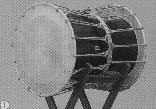| About Taiko Drums
|
| Taiko simply means gdrumh in Japanese, but is most often used in reference
to Japanese drums. (In the Japanese language, the word gdoramuh, from
the English gdrumh is often used to distinguish snare drums, bass drums
and drum kits from their Japanese counterparts.) Saying gTaiko drumsh
is actually repeating the same word twice, but it helps to differentiate
between western and Japanese drums. |
 |
| When the word "Taiko" is used as a suffix of another word, the pronunciation changes to the derivative gDaiko.h Hence the characters above are read "MeitoDaiko", not "MeitoTaiko." The members of Meito Daiko play Taiko (drums.)
Meito means "Famous Swords," a name that derives from Osafune's historical reputation for sword making. (Click here to read about the history of Osafune.)
|
 |
 |
 |
 |
Taiko Drums are made in much the same way as drums anywhere else in the
world. The drum's skin is made from animal skin (usually leather in Japan)
stretched over the hollowed out trunk part of a tree. The skin can be fixed
to the body of the drum with nails or stretched with ropes. Taught skins
produce higher tones, while thicker leather lasts longer. The sound quality
and patterns in the leather vary depending on which part of the animal
is used. |
| Another type of drum can also be made by combining pieces of wood to create the cylinder, either in two halves (like a glass bottle) or in multiple parts bound together (like a wine barrel.) These drums tend to be lighter, but also tend to split open with age. |
 |
| Drum sticks (bachi) are also wooden, and come in innumerable sizes. Larger, longer and heavier drumsticks produce larger sounds, but tend to be more difficult to control when complex, faster rhythms are required. By tapering the head or the handle accordingly, a balance between volume and control can be reached. Drumsticks differ according to the size of the drum, and the playing style. (See Meito Daiko's list of performance pieces for examples of different postures.)
It is not unusual for Taiko drummers to choose between seemingly identical drumsticks, purely because the humidity of the day affects the weight of the sticks, and the grip.
Cymbals and gongs of various sizes are also used to add color to some performance
pieces. These require different sized drumsticks (hammers) also. Drums
have been made in this manner since ancient times, and the fact that the
drums and the drumsticks are all made of natural products is important
to Taiko drummers. We treat all our equipment with respect, and in so doing
show our respect for Nature, which has provided everything to us. |
|
|